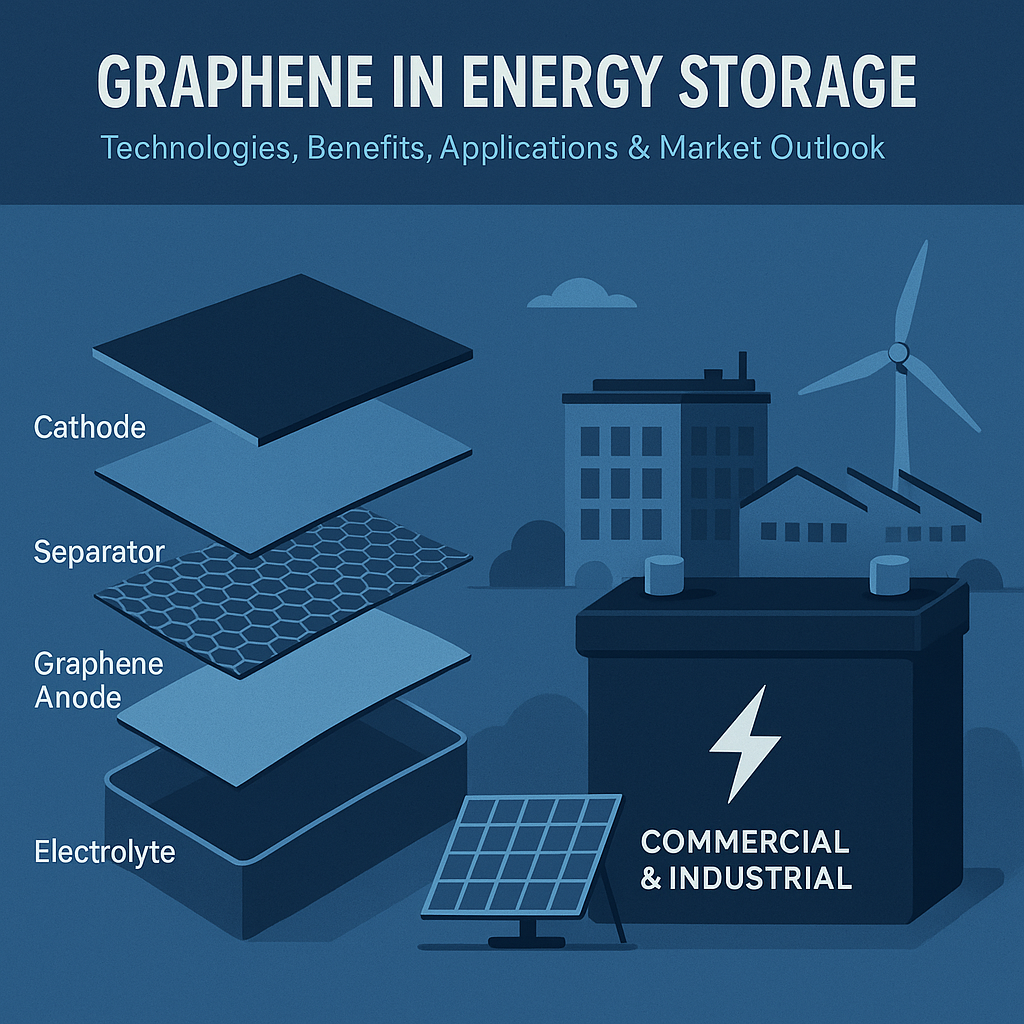Graphene in Energy Storage: Technologies, Benefits, Applications & Market Outlook
What is Graphene Energy Storage?
Graphene energy storage refers to the use of graphene-enhanced materials in batteries and supercapacitors to improve energy density, charge speed, cycle life, and thermal stability. As one of the most conductive and mechanically strong materials ever discovered, graphene is redefining the performance limits of next-generation energy storage solutions.

From graphene-lithium batteries to graphene-based supercapacitors, this nanomaterial is enabling high-efficiency, fast-charging, and long-lasting storage systems—ideal for both grid-scale and commercial & industrial (C&I) energy applications.
How Does Graphene Improve Energy Storage?
Graphene is typically used in one or more of the following battery components:
-
Anode materials (e.g., graphene-silicon composites)
-
Cathode coatings (for enhanced conductivity)
-
Electrolyte supports (improved ion transport)
-
Current collectors or separators (stronger, lighter)
These integrations result in significant performance boosts:
-
⚡ Faster charging and discharging
-
🔋 Higher capacity and energy density
-
🔁 Longer cycle life (over 5,000 cycles in lab tests)
-
🌡️ Better thermal management and safety
Types of Graphene-Based Storage Technologies
| Technology | Description | Typical Use Cases |
|---|---|---|
| Graphene-Lithium Ion Batteries | Enhanced with graphene anodes or coatings | EVs, C&I storage, telecom backup |
| Graphene Supercapacitors | High-power density, ultra-fast charging | Power smoothing, grid balancing |
| Graphene-Aluminum Batteries | Fast-charging, low-cost, still in R&D | EVs, renewable integration (future) |
| Hybrid Graphene Systems | Combined with CNTs or silicon for higher capacity | High-performance stationary storage |
Advantages of Graphene in C&I Energy Storage
✅ High Power Delivery
Ideal for peak shaving, fast discharge, and backup switching in industrial environments.
✅ Faster Recharge Time
Reduces downtime in critical facilities like data centers, cold storage, or manufacturing plants.
✅ Improved Battery Safety
Graphene reduces overheating risks, supporting safer large-scale deployment in commercial buildings.
✅ Extended Battery Lifespan
Longer cycle life reduces OPEX and improves total cost of ownership (TCO).
✅ Compact and Lightweight
Enables high-energy density systems in limited space, perfect for urban storage systems and microgrids.
Graphene in Renewable + Storage Systems
Graphene storage technologies pair exceptionally well with:
-
☀️ Solar PV Systems – Store excess solar power during the day, discharge during peak times
-
🌬️ Wind Energy – Smoothing fluctuating generation, providing instant backup
-
🔋 Hybrid Microgrids – Ensure stability and responsiveness in off-grid or islanded systems
The fast-response nature of graphene batteries and supercapacitors makes them perfect for frequency regulation and demand response programs.
FAQ: Graphene for Energy Storage
Q1: Are graphene batteries commercially available?
Yes, several pilot-scale products are on the market, especially in EV and consumer electronics. C&I-scale deployment is emerging.
Q2: Are they more expensive than lithium-ion?
Currently yes, but costs are dropping rapidly as production scales and graphene supply chains mature.
Q3: Is graphene storage safe?
Graphene enhances thermal control, reducing fire and explosion risks—critical for C&I and grid applications.
Q4: Can graphene storage be retrofitted into existing systems?
Yes. Many systems are modular and can replace or supplement existing lithium-ion setups.
Market Outlook & Industry Adoption
The global graphene battery market is expected to grow at +28% CAGR through 2030, driven by:
-
🔋 Growing demand for high-performance C&I storage
-
🌍 Global decarbonization and net-zero targets
-
🏭 Demand for long-life, low-maintenance storage in industrial facilities
-
💡 Innovation in graphene-silicon anodes and hybrid energy systems
Countries including the US, China, South Korea, Germany, and UAE are investing heavily in pilot projects and scaling production.
Conclusion
Graphene-enhanced energy storage is not just a lab concept—it’s an evolving industrial solution. With advantages in power delivery, thermal safety, and long-term reliability, it holds immense promise for C&I storage, renewable integration, and grid stability.
As the technology matures and costs decline, graphene batteries and supercapacitors will become key players in the energy transition.
📩 Interested in sourcing graphene-based storage materials or building custom C&I energy systems?
Reach out to our team to learn how cutting-edge nanomaterials can power your future.
New Energy for more reading

